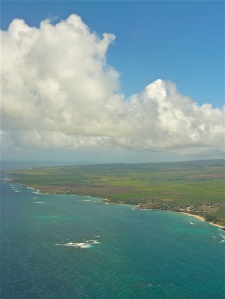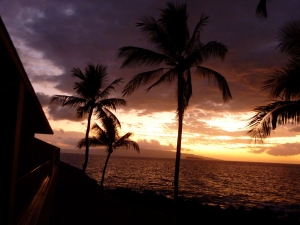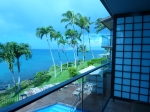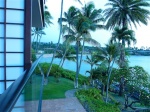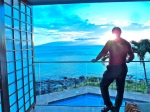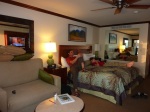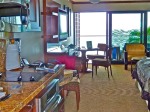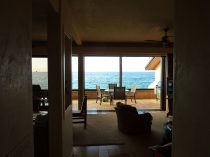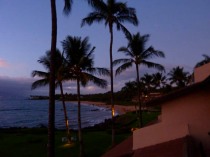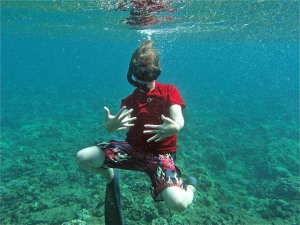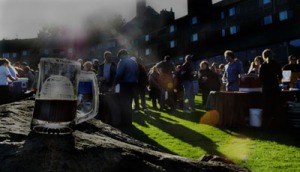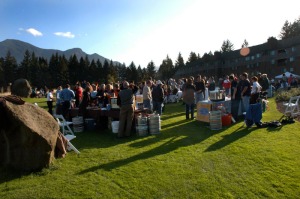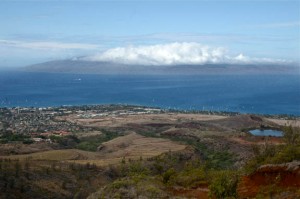
From my vantage point on the flanks of the West Maui Mountains above the Ka’anapali beach resorts area, I am suddenly convinced I can see spouting humpback whales and pirouetting spinner dolphins.
Of course, that’s impossible—I am many miles from the sea, and this kind of illusion is pretty common in Maui. It’s what makes this place a reliable trickster of sorts.
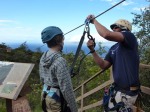 Since I have been here before I recognize the deceit as quickly as it ensnares me. Fact is I am standing about 1,500 feet above the Pacific Ocean on steps leading to a wooden platform some 500 feet above a scrub- and tree-studded arroyo strapped into a seat harness—the kind you wear for rappelling or climbing. My eyes fix wearily on a galvanized aircraft cable stretched 400 feet across a deep gully in front of me. I look over at my kid and my gut knits itself into a knot.
Since I have been here before I recognize the deceit as quickly as it ensnares me. Fact is I am standing about 1,500 feet above the Pacific Ocean on steps leading to a wooden platform some 500 feet above a scrub- and tree-studded arroyo strapped into a seat harness—the kind you wear for rappelling or climbing. My eyes fix wearily on a galvanized aircraft cable stretched 400 feet across a deep gully in front of me. I look over at my kid and my gut knits itself into a knot.
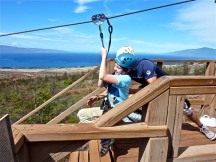 But then, out of the blue, my typically shy 12-year-old, who always seems more cautious than adventurous, surprises me by volunteering to go first on stage one of eight progressively longer cable runs that straddle the valleys of Mount Kahalawai; the last one a span of 1,100 feet.
But then, out of the blue, my typically shy 12-year-old, who always seems more cautious than adventurous, surprises me by volunteering to go first on stage one of eight progressively longer cable runs that straddle the valleys of Mount Kahalawai; the last one a span of 1,100 feet.
Our guide, B.J., of Ka’anapali Skyline Eco-Adventure, delivers a rapid-fire spiel that includes a crack about his name followed with a funny but serious safety drill. His delivery is so wildly snarky and hilarious that it distracts me from my kid who’s now being clipped into the speed trolley that will carry him across the tops of several trees and a yawning abyss.
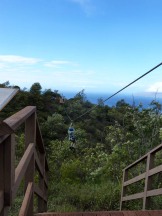 Before sending him off, B.J. quips: “Sam, I have some advice for you. Listen carefully: never date girls with tattoos, and, please, don’t ever get one yourself: “You wouldn’t put a bumper sticker on a Ferrari, would you?”
Before sending him off, B.J. quips: “Sam, I have some advice for you. Listen carefully: never date girls with tattoos, and, please, don’t ever get one yourself: “You wouldn’t put a bumper sticker on a Ferrari, would you?”
My son cracks up, and I break into a mile-wide smile as I watch my baby boy sail away.
For the time being, I have forgotten my worries and am reveling in the pure joy of the moment.
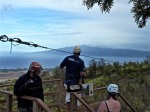 One by one the rest of the group launches as I wait my turn taking in the 360 degree views. Rolling clouds break across the horizon, and I see clearly why Maui is also known as the “Valley Isle.”
One by one the rest of the group launches as I wait my turn taking in the 360 degree views. Rolling clouds break across the horizon, and I see clearly why Maui is also known as the “Valley Isle.”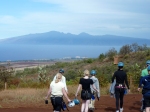
Two former shield volcanoes connected by an isthmus dominate the landscape, overlapping at their feet to form a large rambling valley.
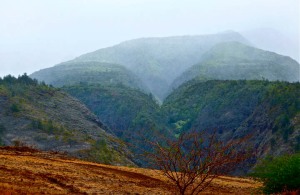
The lush green, oft cloud-shrouded West Maui Mountains extend some 5,788 feet skyward, and extend like a paw from the rest of the island. Crowned by distinctly eroded peaks sliced with steep gullies, the mountains slope toward a rocky surf-slammed shoreline punctuated with sandy beaches ranging from long and curved to small and gem-like.
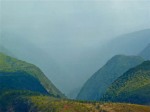 Haleakala, the younger and more massive volcano to the east, rises to more than 10,000 feet above sea level. Its’ bulbous upper flank is dotted with volcanic rock and scrub before makes its way gradually toward sporadically lush agricultural fields and long arching sandy beaches.
Haleakala, the younger and more massive volcano to the east, rises to more than 10,000 feet above sea level. Its’ bulbous upper flank is dotted with volcanic rock and scrub before makes its way gradually toward sporadically lush agricultural fields and long arching sandy beaches.
Together these distinctly different mountains encompass five major geographical areas: the cozy-clutch beaches of Napili and Kapalua Bays; the action-oriented Ka’anapali just north of Lahaina and its overdosed shopping; bustling Kihei; the more serene areas of Wailea-Makena; and, finally, at the island’s southern terminus, the wild and rugged Ahihi Kina’u Natural Area Reserve and La Perouse Bay.
Like beaches in Oregon, all Maui beaches are freely open to public access. While Maui is well known and coveted for these beaches and the adjacent ocean-based activities, it’s really the whole of the thing—the varied terrain, plant life, fish, fauna, geology, and climate variations—that attract adventure travelers and outdoors enthusiasts from across the globe.
Let the Adventure Begin
We started our trip in Kahalui, where most flights land, hitting Whole Foods to stock up on groceries. We booked vacation condos for our week-long visit and planned to cook most meals rather than dine out as a cost-cutting strategy. Each of the distinct accommodations we selected are ideally furnished and perfectly located for active travelers.
The first place we stayed, Napili Kai Resort, is located in a quiet coastal area in West Maui; the second, Ka’anapali Alii, in the Ka’anapali Beach area; and the third, Makena Surf, is at the far end of Wailea in the south. All are within 45 minutes of the airport in Kahului. We decided to divvy up our stay with different locales, so we could experience each of these distinct areas; and they all offer exceptional discounts for seven days stays.
Each of these condos feature sliding glass doors that seamlessly roll open to expansive ocean views and a quintessential island soundtrack: birds singing, surf surging and geckos chirping.They also have washing machines and dryers, along with gourmet kitchens stocked with every tool you need to prepare meals for two to eight people, and all but the first of them could have easily accommodated as many sleeping. You’ll find many other conveniences of home, from iPod docking stations and flat screen televisions to games and books, and beach toys, snorkels, fins, and beach chairs. For travelers looking for a true home away from home for a week or two, any of these would do superbly.

Both Napili Kai and Makena Surf, by virtue of their locations, provide quick access to crowd-free exploring—whether for a bike ride down roads with low traffic counts or beachfront snorkeling where plenty of coral, fish, and sea turtles are regularly on the viewing menu.
The wide arching beach at Napili Kai is fronted by a stunning oceanside, open-air restaurant, the Sea Horse. At night, tiki torches illuminate the sprawling property’s narrow pathways and palm trees, while the surf rolls in and purges out, creating a synchronized symphony of light and sound.
But Ka’anapali Alii also offers something special—an incredible state-of-the art fitness facility. This is no cramped hotel-style gym but one with premium cardio and circuit training equipment, free weights and a yoga studio, sweetened with palm-tree fringed views of the mountains. Occupying its own separate space in a separate building in the condo tower complex is an incredibly well-designed, beautifully appointed, soothing spa, Kaanapali Alii’s spa is headed by a highly skilled Mauian massage therapist with a deep holistic background and uncanny resemblance to the actress Sarah Jessica Parker. After a day of rigorous play, she magically worked my knotted muscles free and released the residual tension I had managed to drag across the ocean with me.
Afterward, I stumbled to the shower like a drunken sailor before heading back to the condo, where I melted onto the lanai lounge chair and didn’t budge for the rest of the evening.
The Overrated Road to Hana
One of the first things people will urge you to do when you mention an impending visit to Maui is the quintessential excursion to Hana. It involves driving your rental car (don’t even think about biking this, really, don’t) to the other side of Maui. If you plan to do this solely as a travel activity, I’d think twice about whether the drive is worth the gas, time and nausea. For one thing, much of the road is a blur of green—yes, jungle green—but green nonetheless. You have to make determined pull-offs and sometimes five- to 10-minute or more drives to see the ocean or some waterfalls. If you enjoy mild nausea and cars careening past you around tight corners, however, go for it. It’s a beautiful drive. But think twice before trying to do this in a day. If you’re going to go, do make the effort to stay at least a night in Hana. Then it’s worth it.
Adventure Time
But really who wants to sit in a car all day when you’re on Maui. Nearly every month, there’s a race or event focused on outdoors pursuits. Plan ahead and book accordingly if you want to participate in any organized events. Things book up fast. In January, the Maui oceanfront is the site of several running events, including the island’s eponymous full and half marathon, as well as 5k, 10k and 15k fun runs and races. In February, there’s the Pacific Whale Foundation’s Half Marathon. In March, The Iao Valley to the Sea Half Marathon, 10k and 5K. April brings the Maui Stage Races, including criterium and time trials. Each September, several other well-known running events are rolled out, including the Hana Relay races, and the Maui Marathon and Half Marathon. In October, there’s the Maui Makani Classic, a major windsurfing competition.
Beyond organized events, the options for land and sea excursions are numerous. The key is to look for a top-notch adventure-devoted outfitter, not just someone who caters to tourists. If you’ll only visit for a week or less, your time is valuable; you’ll want an expert to guide you.
For paddling (sightseeing, snorkeling, photo safari or fishing adventures), the outfitter Maui Kayaks is unparalleled. Their experience and attention is comprehensive; they stage, provision and transport all necessary equipment, snorkel gear, refreshments, snacks and meals to your chosen adventure launch site. Experienced kayakers can do this independently with rented equipment and a safety briefing. But be advised that it cannot only be challenging, but often hazardous launching from much of Maui’s shoreline. If this is your first trip to the island, it’ll be more than worthwhile to seek out Maui Kayak’s expertise. Their in-depth knowledge of marine life (where the green sea turtles, spinner dolphins and humpbacks can be found), the geography, water conditions, and local culture is in total: priceless.
Self-confessed water rookies but “hardcore” adventurer travelers, Amanda and Jake Cooke from Phoenix, call Maui Kayaks “awesome at getting you up to speed, fast.” Both reported feeling happily “wiped out” after their 4-hour snorkeling excursion.
Michole Jensen, an experienced kayak fly angler, who blogs at kayakflyangler.com, enjoyed several hours of successful catch and release fishing from one of Maui Kayaks’ Hobiecats, guided by one of their ace fishing guides.
Ziplining, however, was a new sport for me. Several companies offer this guided adventure on Maui. I studied online reviews, cost-versus-itinerary schedule and group size, as well as the weather forecast. I also considered accreditation (from dependable groups like the Better Business Bureau, American Trade Travel Association and Ecotourism Society), as well as input form the Maui Visitor’s Bureau, and, finally, went with Skyline Eco-Adventures after learning about their membership in 1% For The Planet,” a group of businesses committed to giving a percentage of their sales back to environmental preservation. They were everything I hoped for, including entertaining and informative, and did a great job with safety drills and providing mid-morning nourishment on our half-day adventure.
For a high sea adventure, I booked with Terlani Sailing Charters, a decision driven by copious amounts of research on Maui boats and crews. Since I was traveling with a child in tow, I considered their state-of-the-art catamarans a big plus. Comfort and safety are critical concerns that are often overlooked by tourists when booking tours. I am more interested in calculated risks, so I did my research. The 35- by 65-foot cats are capable of accommodating 100-plus passengers, but they max out their tours at 49 guests. Additionally, their cats are equipped with decent heads (restrooms), fresh water showers, and outdoor and indoor seating (including tables under a covered salon and bar). They conveniently launch from Ka’anapali’s Dig Me beach, just off the mile-long, palm-tree studded boardwalk that fronts a dozen or more resorts along this beautiful sandy oceanfront. Trilogy, Maui’s oldest family owned and operated sailing company also offers state-of-the-art catamarans and tours, and is another top-rated tour transporter/provider. More recently, they started sailing right off Makena Beach, which is certainly the best option for anyone staying in the Wailea-Makena area who wants to go out to Molokini to snorkel.
The Terlani sailed about an hour north to a Honolua Bay before dropping anchor. We snorkeled for an hour in a pretty rough surf, and then submerged with SNUBA lines 20 feet or more to the calmer sea floor where the fish view was much better. Not only was there no surge to deal with underwater, but we also saw a sea turtle—described by my son as being as big as a VW Beetle—serving as a feeding station for a colorful array of fish.
Back on board the cat, and absolutely famished after spending several hours in the water (never underestimate how hungry you can get when playing in water), we dove into a fabulous BBQ and deli-style buffet. Then we sat back and relaxed on our return sail to Ka’anapali, escorted by a spirited pod of Spinner dolphins.
Play Eat Sleep Repeat
You know you’ve made the transition from your workaday life to real travel when you can relinquish your routines, but just as we quickly settle into another set of them—starting the day early and then playing (insert nearly any fun activity here) until we can barely stand up and following that with nights doing nothing more than kicking back. When I travel, I also like to try to stay on Pacific Time, which means very early mornings and fairly early to bed. This is one of the best ways to easily transition back into reality after I’ve take trips involving a time warp into other time zones.
Typically, we would awake around 4:30 for coffee and protein smoothies before heading out by foot or rented bikes, and more rarely, the rented car. One day, we enjoyed 20 fast and furious cycling miles along the Piilani Highway, the central coast beltline road, with little traffic to impede us. Another day, we drove up to the Upper Waiakoa (aka “You’ll be Sorry”) Trail, a challenging ride that encompasses smooth to seriously steep terrain, with stretches through pine forest, tread-devouring lava rock, and dicey sand and scree.
We did not, however, do the quintessential sunrise downhill bike bomb off Haleakala, as it seemed too touristy, although many active travelers swear by the experience.
Instead, we trekked around the super rocky and choppy La Perouse Bay to the Hopaili Trail. The bay is next to the Ahihi Kinau Nature Reserve, an area that encompasses 2,000 acres of land (mostly lava flow) and submerged areas. Large pods of Spinner dolphins frequent the bay, using it as a resting area and nursery. Reserve managers surely considered this (and undetonated ordinances, and the fact that overuse has seriously impacted the reserve) in their decision to close the reserve through July 2012 to allow the fragile eco system to recover. (Update: parts of it have been re-opened, particularly if you go with a guide).
If there’s one adventure that can’t be missed on Maui—and pretty much the raison d’etre for traveling to the island state in the first place—it’s the snorkeling (although if you’re a diver you could argue that). You can book a catamaran boat tour out to the crowded waters of Molokini Crater (where as many as 2,000 people at a time snorkel the small caldera-shaped atoll’s natural aquarium).
If you feel compelled to do this, consider booking with outfitters that use fast-moving boats (like Seafire and Blue Water Rafting, both out of Kihei Boat Harbor). They’ll get you to the best snorkel sites quickly before the crowds arrive. They can also change course on a dime should visibility or crowds becomes an issue, something the bigger boats can’t do.
The crater, many argue, offers the best scuba diving on Maui. Depths reach more than 100 feet, in some places 300. If you’re a diver with your heart set on diving, sign up with a dive boat operator out of the Kihei Boat Harbor. They make the trip in 15 minutes rather than the 45- to 60-minute sail out of Ma’alaea Harbor.
Next to Molokini, few snorkel or scuba spots possess the diversity of fish and marine life found at Nahuna Point, also known as Five Graves, Five Caves.
It’s possible to swim to Nahuna Point from Makena Surf or Makena Landing, which is partly why we chose a condo in this area. But keep in mind, it’s only a viable option when the water is calm. The other option is to a quarter mile walk from the Makena Landing Beach Park public access lot off Makena Road to a residential area on the right where you navigate around a tiny rather grim-looking private graveyard, which is nearly as creepy as the sketchy entry into the narrows of the small cove.
Uneven and slippery, there are a lot of large rocks in the shallows of the cove. As soon as we were in the water, we had to kick it into high gear as the surf surged quite hard, flushing us back in and out with it.
Once in the cove, we followed a sea turtle out along the coral-rich lava shelf. All around us we saw eel, octopus, and a variety reef fish like the indigo dart, butterfly, puffer and triggerfish, dragon wrasse, Moorish idols, and, more rarely, the frogfish.
The first of the five caves is just beneath this stretch of reef. At the end of the reef as it heads out to sea, turn right and head over the top of another reef before turning west southwest back into another small bay to the other four caves. Divers often see white tip sharks resting in these caves.
They’ve dubbed the third one the “bubble cave” because it contains an air chamber, and if you dive into it with only a snorkel, you can stand up and catch your breath inside. Visibility in this area varies wildly depending on conditions; if the surf is big, diving and snorkelling here can both be difficult endeavors. And by mid-morning big boats start arriving to drop off loads of tourist snorkelers, although only a few in-the-know, ever really venture in as far as the caves.
At the End of the Day
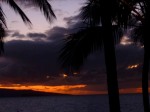 After a day of adventuring, we’d roll open the lanai doors and take in the unfettered view of the ocean and its companion soundtrack—the rhythmic crescendo of the surf crashing on the beach a few yards off.
After a day of adventuring, we’d roll open the lanai doors and take in the unfettered view of the ocean and its companion soundtrack—the rhythmic crescendo of the surf crashing on the beach a few yards off.
On our final night in Maui, I watched with a touch of resignation as the night began to unfold, the sky subtly shifting from blue to orange to red to purple, and finally inky black.
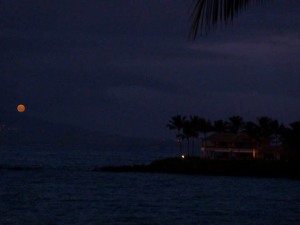 And then there it was again, that Maui trick: As the moon rose steadily into view and began spilling its light, it looked very much like someone carrying a lantern across a vast infinity pool.
And then there it was again, that Maui trick: As the moon rose steadily into view and began spilling its light, it looked very much like someone carrying a lantern across a vast infinity pool.
That final night, I drifted to sleep on a lounger on the lanai, dreaming of Sam sailing across the sea from the mainland to Maui on an endless zipline with me in fast pursuit.
Resources/Planning
SLEEP:
Napili Kai Beach Resort Online at www.napilikai.com; by phone
1-800-367-5030, direct (808) 669-6271, by email stay@napilikai.com. This intimate 10-acre resort provides one of most authentic traditional Hawaiian ambiances I have encounter on Maui. Perched above a stunning crescent sand beach with no building higher than two stories, and surrounded by alternative manicured and lush wild grounds, it is also one of the only beach resorts I’ve visited that stands behind the “value-plus” pitch. You won’t pay separately for a long laundry list of typical extras like parking, kids activities, hula and lei making classes, nightly live music, fitness studio, putting greens, snorkel gear and kids eat free. So although the accommodations can look spendy to families, when you add these things in, you’ll save money here.
Kaanapali Alii Oceanfront Residences: Online at kaanapalialii-px.rtrk.comby phone 866-627-7023. Definitely a luxury property, but with a family or group, you will definitely save money at this pampering property, especially if you take advantage of the incredible outdoors BBQ area or the fully stocked gourmet kitchens.
Land
•Ziplining. Ka’anapali Skyline Eco-Adventures—online at www.zipline.com/locations/kaanapali; by phone Ph. 808.878.8400; by email.info@zipline.com.
• Cycling. Rent Specialized road or mountain bikes at Island Biker Maui— online at www.islandbikermaui.com; by phone at 808-877-7744; by email rjn@maui.net.
Water
•Sail/Snorkel/Snuba: Teralani Sailing Charters—online at www.teralani.net; by phone at 808-661-7245.
• Snorkel: Seafire—online at www.molokinisnorkeling.com; by phone 808-879-2201.
• Scuba: Mike Severns Diving—online at www.mikesevernsdiving.com; by phone 808-879-6596.
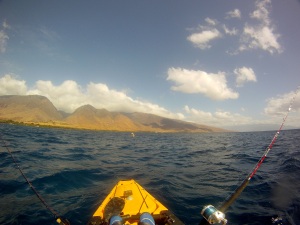
• Kayaking: Maui Kayaks—Online at www.mauikayaks.com; by phone 808-874-4000.
EAT
Whole Foods Market: 70 E Kaahumanu Ave # B Kahului. Despite the “whole paycheck” reputation, there are some bargains to be found here, particular the salad bar and hot prepared foods, and wine department.
Leilanis in Whalers Village (www.leilanis.com/menus/dining-room; 808-661-4495). Directly adjacent to the surf along the Ka’anapali beach front, this is the go-to place for fresh fish and seafood (like to die-for sesame encrusted fresh Hawaiian ahi with lilikoi balsamic glaze and wasabi cream), a terrific selection of island fresh salads and pupus (ahi with wasabi and pickled ginger), and oceanfront views that will turn you into a table squatter. Prices are no higher than fine dining on the mainland.
Hula Grill Kaanapali (www.hulagrill.com; 808-667-6636), also on the beach at Ka’anapali, this very popular open-air dining spot has a laid back but always crowded vibe. The 3-course meal chef’s tasting menu is the way to go. This is also a great place to sip a beer and groove to live music.
Sea House Restaurant at Napili Kai Beach Resort http://www.napilikai.com/dining-entertainmnet/ This gorgeous open-air restaurant and bar, located right above one of Maui’s prettiest oceanfront resort beaches, serves breakfast, lunch, and dinner daily. The Sea House’s casual yet elegant ambiance and quintessential Maui setting make dining at sunset from the special three-course menu one of the most romantic dining experienes on Maui. The daily dinner menu includes an outrageously fine Seafood Chowder, housecrafted from supremely fresh local fish, clams, shrimp, vegetables, and is surely one of the island’s best versions of this filling soup. A baby spinach salad mixed with Gorgonzola, candied macadamia nuts and crisp Molokai sweet potato strings, and dressed with papaya seed dressing and finished with sliced fresh papaya is as delicious to eat as it is to look at. Best of all, the menu includes enough variety of seafood, meat, vegetarian and gluten-free options to keep everyone happy. And for those of who really do keep track of these things, the menu is certified to be ecologically responsible through sustainable fishing practices. Their membership in Seafood Watch means the chef and staff are committed to protecting the oceans. One other thing, the wine, beer and cocktails are no more expensive then you’ll find in most big city in the U.S., and include a small but nicely chosen selection of vintages, brews and creative libations. Enjoy Happy Hour on the terrace from 2pm until 5pm; Hawaiian entertainment is featured from 7pm until 9pm most nights.
Honokowai Farmers Market located at 3636 Lower Honoapi’ilani Road near Lahaina. This tiny natural food store is open daily, inside the building, while the farmer’s market is held outside in the parking lot on Mondays, Wednesdays and Fridays. This is a good place to pick up some homemade guacamole (or the fixings for it: avocados, basil, onions and cilantro), and fresh island fruit like papaya, pineapple, apple bananas, mango, guava and passion fruit (nicely, you won’t find imported fruit from China). They also have a wide range of baked goods and vegan foods. Good place to pick up lunch to go as well.

